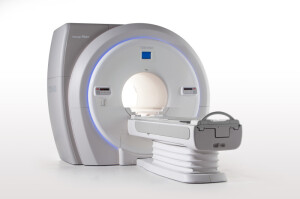by
Thomas Dworetzky, Contributing Reporter | June 21, 2017
A fidgety patient, provoked by noise, repeated breath-holds and other demands, can ruin even the best-planned MR scan.
To ease the discomfort and speed workflow, Canon's Toshiba Medical has announced its latest MR system, the Vantage Titan / Zen Edition 1.5T.
“Toshiba Medical puts customers first by delivering advanced technology with patient-friendly features, so they can provide exams that are quiet, comfortable and faster,” Dominic Smith, senior director, CT, PET/CT, and MR Business Units, Toshiba America Medical Systems, said in a statement.



Ad Statistics
Times Displayed: 2890
Times Visited: 28 Fast-moving cardiac structures have a big impact on imaging. Fujifilm’s SCENARIA View premium performance CT brings solutions to address motion in Coronary CTA while delivering unique dose saving and workflow increasing benefits.
The new system has several features that make patients calmer and help to boost workflow.
To address the clanging, banging noise issue, so provoking to many patients, the system has Pianissimo Zen Edition software that cuts sound during acquisition 99 percent by unit of Loudness level “dB” when mUTE or mUTE 4D-MRA sequences are used.
Toshiba had
previously featured the Pianissimo Zen technology in its Vantage Galan 3T MR, which received FDA clearance in 2016.
Talking about the Galan 3T's noise reduction at that time, Jon Furuyama, product manager of MR at Toshiba, told HCB News that the gradient coil is placed into a vacuum chamber to lessen the amount of noise that's transmitted.
"It doesn't even sound like a scanner" said Furuyama, who described the noise as more of a "light buzzing."
The Vantage Titan also “includes enhancements to a comprehensive suite of innovative clinical applications, intelligent technology and an intuitive user interface that increases efficiency and workflow,” Smith stated.
Cardiac workflow is enhanced with Multi-echo T2* Mapping that maps with Toshiba Medical’s updated FFE2D mEcho sequence that can be used in quantification and analysis of myocardial iron overload.
Cardiac capabilities are also expanded to include T1 mapping utilizing a Modified Look Locker Inversion (MOLLI) sequence that permits the acquisition of “a more quantitative characterization of myocardial tissue within a single breath-hold.”
To facilitate increased comfort during cardiac exams the system has Phase Sensitive Inversion Recovery (PSIR) in the heart to improve contrast in late-enhanced imaging and eliminate the need for calibration.
This “allows cardiac exams to be completed with fewer breath-holds and greater patient comfort,” according to the company.
Additional clinical capabilities include the system's Ultrashort Echo Time (UTE), which captures images in tissues “that generally disappear too quickly for accurate MR imaging, enabling imaging of anatomy such as the MSK and lungs to help providers obtain more information to diagnose and treat their patients.”
To make workflow faster, the system has a feature called EasyTech, which provides automatic positioning, including automatic slice alignment for tricky studies like cardiac, neuro and spine exams, while delivering consistent image quality.

